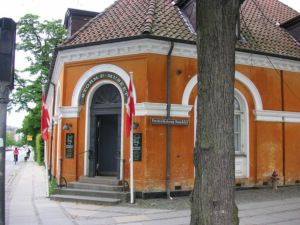Business & Education
Denmark’s greatest wit: The life of a tramp seen through the eyes of the Storm
This article is more than 8 years old.
Find out more about the father of Danish humour at his very own museum

The Storm P Museum is situated at Frederiksberg Runddel and open Tuesday to Sunday 10:00-16:00
Just the mention of Robert Storm Petersen’s name is enough to get many Danes chuckling merrily away.
Storm P (1882-1949), as the father of Danish humour is affectionately known, is often compared by his countrymen to Mark Twain or Jerome K Jerome, whose works he illustrated when they were published over here.
His life was a sketch show
The accomplished artist, writer and performer has become a national institution. Most people know at least one or two of his jokes off by heart.
In almost every home – at least in those of the pre-techno generation – a compendium of his drawings can be found. He produced around 70,000 sketches and cartoons during his working life, from the turn of the century until his death, so there are many to choose from.
From the abattoir to the academy
His father worked in a slaughterhouse, and in his early youth Storm P apprenticed in the same trade. He has told how he was unable to complete the apprenticeship because the eyes of the condemned animals always seemed to be catching his own.
Storm P had a great deal of affection for animals and, as he once explained, he had met some of the best people in dogs.
He sketched and painted all his childhood, and some time after quitting the butchers’ trade, he entered the Academy of Fine Arts.
Prodigiously active, he developed quickly as an all-round entertainer, performing in films and in the theatre, and as sort of a forerunner to modern day stand-up comedians, reading aloud from his stories to audiences all over the country.
In tune with the tramps
One of Storm P’s favorite themes in his cartoons and drawings was the lifestyle of tramps. A look at his work through the years reveals a subtle development in his perception and presentation of them. In his earliest drawings these vagabonds are rough and hungry figures, escaping the hardships of homelessness and unemployment by drinking too much.
As the years pass, Storm P’s hardly vagabonds become more contented with their status, living on the fringes of society by choice rather than need, taking to the road to avoid a day’s work, rather than in search of one. They are still drunk most of the time, but in a leisurely rather than a desperate manner.
Gradually, the non-conformist replaces the revolutionary. Storm P’s captions change from sharp and satirical to whimsical and tolerant. The tramp becomes a romantic king of the road, savouring freedom, sunsets and birdsong – a curious observer of the staunch citizens around him who live to work and work to live.
Let them me eat cake!
Here is one of many such scenarios: Our tramp arrives on the doorstep of a bourgeois housewife, politely doffing his cap. “Has Madame perhaps a small slice of cake for a hungry man who hasn’t eaten in two days?”
“Cake!” exclaims the lady of the house, “Cake? Isn’t bread good enough for you?”
“Well, ma’am, normally it would be,” replies our hero. “But today’s my birthday.”
A whole museum
Storm P was a multifaceted talent, and in his other work, particularly his paintings, he remained more consistent to the social criticism of his youth.
To date no English version of Robert Storm Petersen’s work exists in print, not least because many of his witticisms would be untranslatable (see below for a selection).
However, at the Storm P Museum at Frederiksberg Runddel, which is open Tuesday to Sunday 10:00-16:00, a few mounted cartoons have had their captions translated into both English and German.
In addition to his paintings and drawings and his huge pipe collection, a replica of his study can be visited.










































